PLASMA
Plasma Physics Group, Department of Physics, University of Milano
Research » Nonneutral Plasmas » ELTRAP
ELTRAP
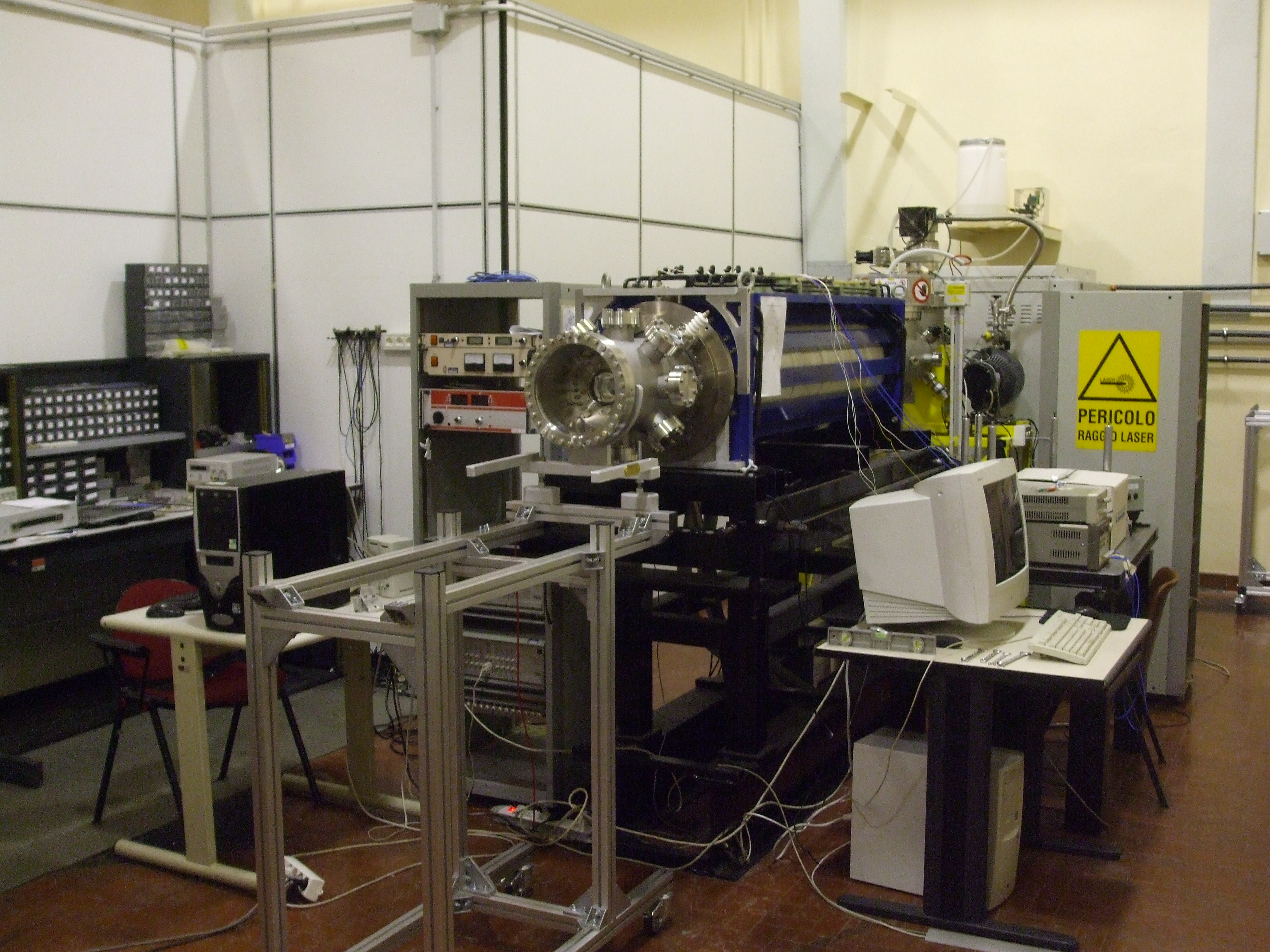
The ELTRAP device installed at the Department of Physics of the University of Milan is a Malmberg-Penning trap, with a magnetic field up to 0.2 T, equipped with charge coupled device optical diagnostics. It is intended to be a small scale facility for electron plasma and beam dynamics experiments, and in particular for the study of collective effects, equilibrium states, and the formation of coherent structures in these systems. The device features a relatively long solenoid, corrected by 4 shims and 16 dipole coils, in order to obtain a large uniform magnetic field region. The modular electrode design allows several variations of the experimental configuration.
MACHINE DESIGN
The apparatus consists of an ultrahigh vacuum (UHV) chamber containing a set of 12 cylindrical electrodes immersed in the magnetic field of a solenoid. The 25 cm vacuum tube (175 cm long) which encloses the electrodes is made of AISI 316L stainless steel to minimize magnetic field perturbations. The chamber is equipped with an ion pump (500 l/s) and a titanium sublimation pump. Initial pumpdown is provided with an oil-free scroll pump and a turbomolecular pump. The background neutral gas pressure in the chamber is measured with a nude ionization gauge, and it is typically of the order of 10-9 mbar. The ion and the turbomolecular pump can be isolated from the rest of the apparatus by means of two electropneumatically operated gate valves, which can be used, e.g., to increase the residual gas pressure in order to study the effect of collisions with neutrals on transport processes.
A. Electrodes
All electrodes are machined of oxygen-free high-conductivity (OFHC) copper, and are mounted, independent of each other, on an aluminum bar held at ground (see Fig. 3). Electrical insulation is guaranteed by circular rings machined of Macor. The internal diameter of the conducting cylinders is 9.0 cm, while their lengths can be 9.0 or 15.0 cm. Longitudinal confinement of electrons is provided by negative voltages applied to two electrodes, and the resulting length of the plasma column can be varied from about 18 to 80 cm. Cabling of the inside of the apparatus uses 50 V UHV compliant coaxial cables. Two of the cylinders are segmented azimuthally, allowing the detection and/or the excitation of azimuthal charge perturbation modes: One cylinder has two insulated sectors, positioned 180° from each other, the other is built of four insulated sectors, positioned 90° from each other. The potentials on the electrodes are controlled by an eight channel wave form generator (time resolution 100 ns, voltage range ±100 V, slew rate 300 V/µs).
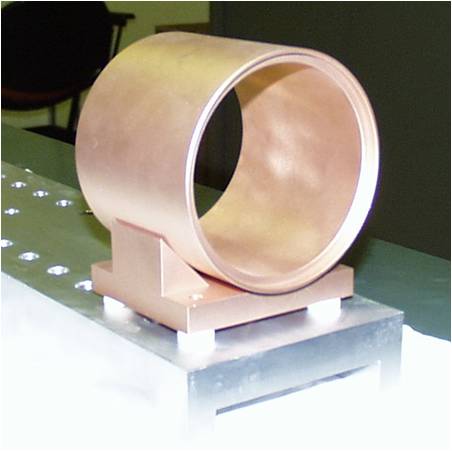
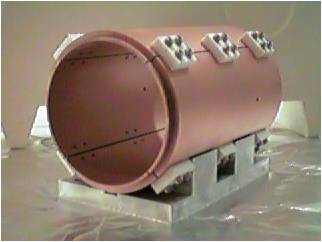
B. Thermionic source
Electrons are thermally emitted from a spirally wound thoriated tungsten filament (with maximum diameter of 2.54 cm) similar to that used in other devices. The source is mounted inside a 4.4 cm long OFHC copper cup, which provides wire alignment and support, and intercepts a part of the radiated heat. The wires are isolated by mullite (a heat shock resistant ceramic) tubes and connected to copper contacts, which are supported by Macor insulators. Two polarizable stainless steel grids are mounted in front of and behind the cathode to control electron emission. The source structure is attached to the nearest electrode, thermally isolated from the bar by a Macor spacer, so as to distribute heat on a relatively large surface. The electron filament is heated with direct current. A preliminary period (a few minutes) of source conditioning at low current is required in order to attain good reproducibility of the injection conditions. With this source emission currents of a few mA have been obtained.

C. Magnetic field
The solenoid is 150 cm long, with an inner diameter of 32 cm. The gap between the vacuum tube and the magnet is useful for the baking system, alignment, and/or additional quadrupole winding. In addition, the solenoid is enclosed in a soft iron cage made of 2 square end plates and 12 axial bars: this simplifies the support system, and also presents a shield against the Earth's magnetic field. The solenoid coil consists of three helical trifilar winding layers. The nine conductors are water cooled in parallel and electrically connected in series. The solenoid current is generated and controlled by a highly stabilized power supply (dI/dt=10-5 A/h, V<120 V, I<600 A). Four dipole correcting coils compensate for errors in the main solenoid winding. Current flowing in the dipole coils is generated by four power supplies, adjustable in voltage or current. If needed, the current direction may be switched, thereby achieving a steering range of 615 mrad at full field (B=0.2 T). The measured field uniformity is better than 10-3 within a distance (from the center of the magnet) of 50 cm along the axis, and within a radius of 5 cm around the axis.
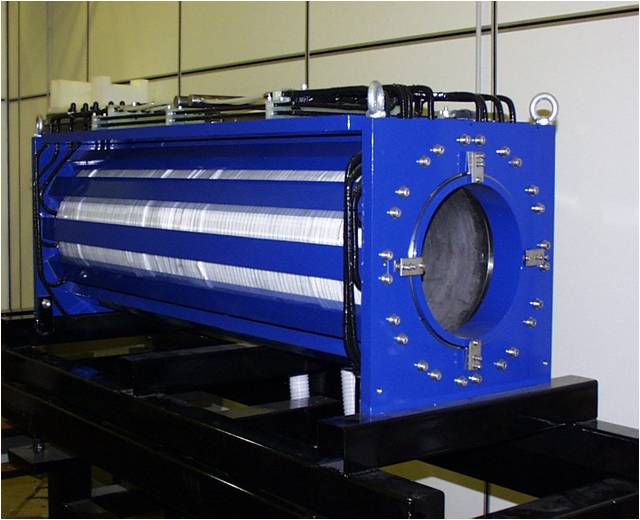
D. Optical diagnostics
Light collection is optimized by mounting the viewport on a reentrant flange. To avoid image distortion, the phosphor screen is placed inside the region of almost uniform magnetic field. Placing the CCD camera close to the phosphor screen is also beneficial, since the solid angle for light collection becomes larger. The phosphor coating (prepared by sedimentation of phosphor grains on a substrate made of BK-7 glass, sealed with a 130 nm aluminum layer) of type P43 (Gd2O2S:Tb) has an emission spectrum from 360 to 680 nm that peaks at 545 nm and a decay time of 1 ms. The efficiency may reach 700-800 photons per electron (with electrostatic potential on the phosphor screen of 15 kV). To increase light efficiency and to reduce stray light, the phosphor coating is sealed with an aluminum layer on top of it. Since the electrons stream along the B-field lines, an axially integrated density is obtained. The acquisition of the data from the CCD camera is controlled by a frame grabber on a personal computer.
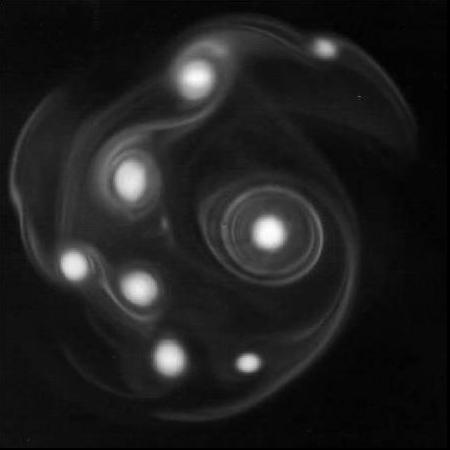
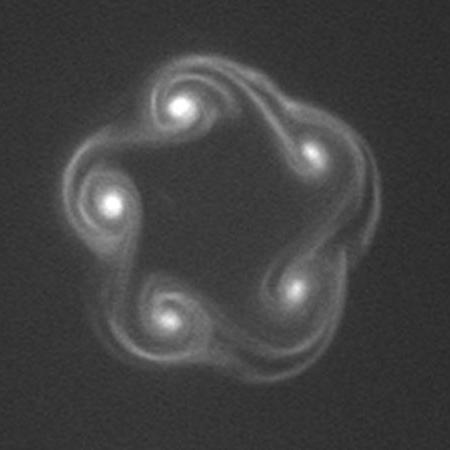
E. Inject-hold-dump cycle
The basic experimental sequence consists of repeated cycles of plasma injection, hold, and dump phases. The injection phase starts when the potential on the plug-in electrod begins to rise: the emitted electrons are accelerated by the front grid to an energy of the order of tens of eV, enter the confinement region and are then reflected back to the source by the plug-out negative potential and fill the trap in a very short time (~1 µs). Control of the initial density profile is obtained mainly changing the potential drop across filament and the bias voltage: a proper choice of these voltages allows the injection of an almost uniform plasma column of variable radius or a plasma ring of variable thickness. While the cathode emits continuously, during the hold and dump phases the plug-in electrode is negatively biased and prevents the electrons from reaching the confinement zone. The application of a step potential or a decreasing ramp on the plug-in electrode starts the hold phase. A potential step can excite compression perturbations and axial particles losses, so the application of a ramp is usually preferable. During hold phase plasma oscillations can be monitored by a simple nondestructive electrostatic diagnostic based on the measurement of the current induced on the electrodes. Both sectored electrodes or any other electrode can be used like an electrostatic probe. The signals are acquired by suitable low-noise amplifiers. The electrostatic probes can also act as perturbation drivers: the two 180° sectors of electrode S2 can be used to induce radial displacement of the plasma column exciting high amplitude diocotron modes; elliptical deformations can be induced by suitable perturbations applied on the 90° sectors of S4. If slow ramp potentials are applied static deformed equilibria can easily be observed. At the end of the hold-manipulation period the plasma is dumped out of the confinement volume and grounding the plug-out cylinder. Electrons flow out and are collected by the thin aluminum layer on the phosphor screen. The charge collected is measured and the average plasma density is estimated assuming a cylindrical plasma volume with base radius equal to the source radius and length equal to the distance between the plug cylinders. The trapped density ranges typically from 106 to 107 cm-3, consistent with other indirect measurements (e.g., the diocotron mode frequency which is proportional to the linear charge density).

F. Electrostatic diagnostics
A personal computer controls the settings of the power supply and wave form generator, the logging of analog signals (e.g., the residual gas pressure) and synchronization of the experiment. Several analog interfaces between the machine and the acquisition system were built to solve specific tasks such as, e.g., slow ramps (rise time >1 ms) and total charge detection. All electric signals are acquired by National Instruments data acquisition (DAQ) boards, PCI-6024E and PCI-6035E. Each board provides eight analog input channels, two analog output channels (for signal generation and remote control), four digital input/output channels, high sampling rates (up to 1 MHz for a single analog input channel) and accurate 16 bit digitalization. A PCI-6601 timer board with a 80 MHz fast internal clock is also used to improve the performance of the acquisition system and for careful synchronization of the events. During the hold phase, low-frequency plasma oscillations are monitored to measure the charge induced on the confining electrodes. The signals are amplified by proper circuitry, conveyed into the input channels of the data acquisition board and acquired. The noise superimposed on the signal is eliminated by a standard software filtering technique applying a run-time fast Fourier transform (FFT) analysis. The time evolution of the frequency and the amplitude of the plasma perturbations can be followed in real time. This technique is also applicable for the study of azimuthal plasma modes. For diocotron mode, amplification can be avoided and after filtering a high (tens of mV) well distinguishable peak that arises from residual disturbance is clearly visible.